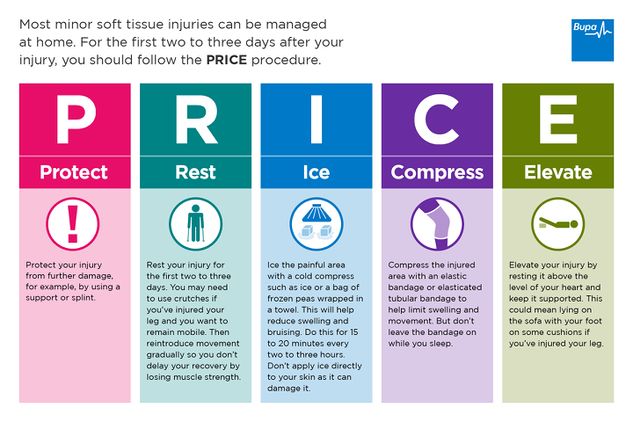Soft Tissue Injuries: Difference between revisions
Abbey Wright (talk | contribs) No edit summary |
Abbey Wright (talk | contribs) No edit summary |
||
| Line 30: | Line 30: | ||
P: protect | P: protect | ||
[[File:PRICE picture.jpg|center|thumb| | [[File:PRICE picture.jpg|center|thumb|633x633px]] | ||
Long periods of rest and protection can be detrimental to recovery, leading to muscle wastage and altered bio-mechanics of the limb.<ref>Bleakley CM, Glasgow P, MacAuley DC. [https://bjsm.bmj.com/content/46/4/220 PRICE needs updating, should we call the POLICE?]British Journal of Sports Medicine 2012;46:220-221.</ref> However, following an acute injury rest and protection of the limb is still recommended in the acute stages. | Long periods of rest and protection can be detrimental to recovery, leading to muscle wastage and altered bio-mechanics of the limb.<ref>Bleakley CM, Glasgow P, MacAuley DC. [https://bjsm.bmj.com/content/46/4/220 PRICE needs updating, should we call the POLICE?]British Journal of Sports Medicine 2012;46:220-221.</ref> However, following an acute injury rest and protection of the limb is still recommended in the acute stages. | ||
| Line 36: | Line 36: | ||
Early mobilisation and weight bearing has been shown to accelerate recovery in acute soft tissue injury<ref>Bleakley CM, O’Connor SR, Tully MA, Rocke LG, MacAuley DC, Bradbury I, Keegan S, McDonough SM. [https://www.bmj.com/content/340/bmj.c1964?ijkey=18b9a5b8a9d5b4191f0f50ac7d7b4f4d05256d99&keytype2=tf_ipsecsha Effect of accelerated rehabilitation on function after ankle sprain]: randomised controlled trial. Bmj. 2010 May 10;340.</ref>. | Early mobilisation and weight bearing has been shown to accelerate recovery in acute soft tissue injury<ref>Bleakley CM, O’Connor SR, Tully MA, Rocke LG, MacAuley DC, Bradbury I, Keegan S, McDonough SM. [https://www.bmj.com/content/340/bmj.c1964?ijkey=18b9a5b8a9d5b4191f0f50ac7d7b4f4d05256d99&keytype2=tf_ipsecsha Effect of accelerated rehabilitation on function after ankle sprain]: randomised controlled trial. Bmj. 2010 May 10;340.</ref>. | ||
=== POLICE === | === [[POLICE Principle|POLICE]] === | ||
POLICE was introduced to promote | POLICE was introduced to promote loading in the affected area and prevent long term immobilisation. | ||
P: protection | |||
O L: optimal loading | |||
ICE: as above. | |||
Optimal Loading has been shown to promote tissue healing and maximizes physiological adaptation.<ref>Glasgow P, Phillips N, Bleakley C. [https://bjsm.bmj.com/content/49/5/278 Optimal loading: key variables and mechanisms]. British journal of sports medicine. 2015 Jan 6:bjsports-2014</ref> | |||
<br> | |||
<br> | |||
== Outcome Measures == | == Outcome Measures == | ||
| Line 51: | Line 55: | ||
add links to outcome measures here (see [[Outcome Measures|Outcome Measures Database]]) | add links to outcome measures here (see [[Outcome Measures|Outcome Measures Database]]) | ||
<br> | |||
== Resources == | == Resources == | ||
Revision as of 17:10, 16 July 2020
Top Contributors - Abbey Wright, Lucinda hampton, Pacifique Dusabeyezu and Kim Jackson
Introduction[edit | edit source]
Acute soft tissue injuries have classically been managed through various acronyms the most well known being RICE and POLICE. These acronyms have been around for many years and focus primarily on the acute stages of a soft tissue injury, as research has progressed these acronyms have become outdated and inaccurate. For example we now know that the use of NSAIDs in an acute injury can actually be detrimental to the recovery and healing process.[1]
The new research has produced new acronyms which can be applied to the acute and sub-acute stages of an injury and promote loading and activity:
History of soft tissue management[edit | edit source]
ICE[edit | edit source]
Initially soft tissue injuries were managed through ICE (Ice, Compression, Elevation) which focused heavily on the use of cryotherapy.
We now know that ice can potentially cause slower healing times as it disrupts normal inflammation and revascularisation. Although there is evidence to show that ice is useful for analgesia. More evidence is required to fully understand the physiological processes that occur when ice is used in an acute injury. [2]
Compression and Elevation are also advised in the ICE acronym. These are mainly anecdotal in recommendation and there is no set advice regarding duration of compression or elevation. Elevation has been show to help reduce inflammation however, this inflammation is normal and is useful in the normal process of healing. [2]
RICE and PRICE[edit | edit source]
RICE and PRICE were then recommended as an addition to ICE.
R: rest
P: protect
Long periods of rest and protection can be detrimental to recovery, leading to muscle wastage and altered bio-mechanics of the limb.[3] However, following an acute injury rest and protection of the limb is still recommended in the acute stages.
Early mobilisation and weight bearing has been shown to accelerate recovery in acute soft tissue injury[4].
POLICE[edit | edit source]
POLICE was introduced to promote loading in the affected area and prevent long term immobilisation.
P: protection
O L: optimal loading
ICE: as above.
Optimal Loading has been shown to promote tissue healing and maximizes physiological adaptation.[5]
Outcome Measures[edit | edit source]
add links to outcome measures here (see Outcome Measures Database)
Resources[edit | edit source]
References[edit | edit source]
- ↑ Dubois B, Esculier J Soft-tissue injuries simply need PEACE and LOVE British Journal of Sports Medicine 2020;54:72-73
- ↑ 2.0 2.1 van den Bekerom MP, Struijs PA, Blankevoort L, Welling L, Van Dijk CN, Kerkhoffs GM. What is the evidence for rest, ice, compression, and elevation therapy in the treatment of ankle sprains in adults?. Journal of athletic training. 2012 Jul;47(4):435-43.
- ↑ Bleakley CM, Glasgow P, MacAuley DC. PRICE needs updating, should we call the POLICE?British Journal of Sports Medicine 2012;46:220-221.
- ↑ Bleakley CM, O’Connor SR, Tully MA, Rocke LG, MacAuley DC, Bradbury I, Keegan S, McDonough SM. Effect of accelerated rehabilitation on function after ankle sprain: randomised controlled trial. Bmj. 2010 May 10;340.
- ↑ Glasgow P, Phillips N, Bleakley C. Optimal loading: key variables and mechanisms. British journal of sports medicine. 2015 Jan 6:bjsports-2014







